Another I hate Australia thread
-
Suppose u just collect new car.But the car dealer ask you pay
few thousand more to 'upgrade' !!
Ha it is just the case of HMAS Dechaineux and HMAS Sheean in
2000 and many more in Collins projects!
2. HMAS Dechaineux near sinking caused by using wrong pipes
No reading .No talking here lah..
After that incident,Collins SSK were ordered not to dive
too deep!!
U think wrong pipes used in sub is small matters??
3. http://www.anao.gov.au/
search Defense to read more lah..
3. 60 % SG naval combatant platforms in operation
http://en.wikipedia.org/wiki/Republic_of_Singapore_Navy
i refer to all SG naval combatant platforms,from sub to
Patrol Boats in the above link.Total no. is 31.
60% just a pure guess.I think actual no. should be higher.
So i assume 18 SG platforms in operation a day.
Pl share w us if u have open sourced info.
4. Belittle Oz?
If a country is really great,i cant do anything to blacken the name.
can I?
So far no hard evidences to challenge my 10 + 10 Oz
platforms defending Oz a day.
It is true supported by links i alreday provide here.
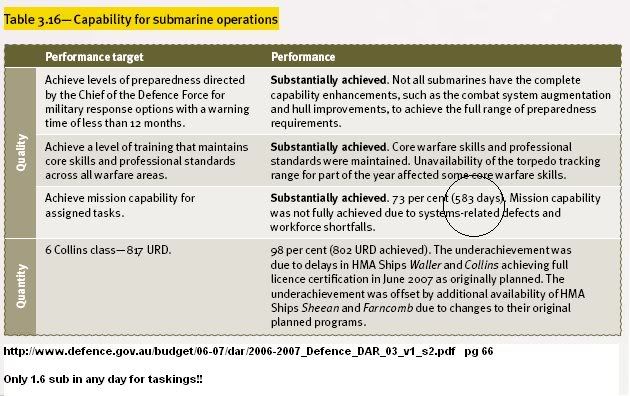
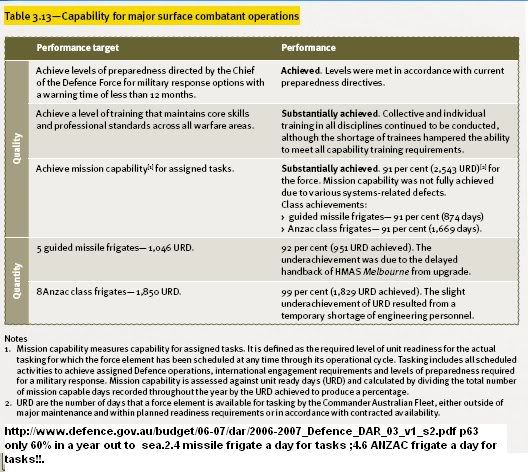
5.Remember HMAS Sydney
How many Oz in WW2 would thought that Oz ship
would be sunk at her door step,by a German sub?
History always can teach us a lesson,unless u take
it seriouly!!
-
6. Complexity of Nuke sub combat sys
only the yanks and oz can make sure old and new sys are combatiable!!Wah! They have to reraun miles of wires!!
http://www.defence.gov.au/dmo/msd/sea1439/sea1439ph4a.cfm
all projects here,
http://www.defence.gov.au/dmo/lsp/index.cfm
-
Another example of you talking out of your imagination.
Whoever said submarines were simple machines to begin with? What matters is that they got the system to work, and now the Collins class submarines are on par with Virginia class SSKs, which are the most advanced in the world.
Going by your logic we should not try to make out SAR-21 compatible with modern "complex" new P-Rail systems and go back to using M1 Garands.


-
3. 60 % SG naval combatant platforms in operation
http://en.wikipedia.org/wiki/Republic_of_Singapore_Navy
i refer to all SG naval combatant platforms,from sub to
Patrol Boats in the above link.Total no. is 31.
60% just a pure guess.I think actual no. should be higher.
So i assume 18 SG platforms in operation a day.
Pl share w us if u have open sourced info.
More nonsense from you.
Basic logic can tell you that in peacetime in our current context it would not be in our favour to even put anywhere near 50 percent of our forces out at sea at any one time. The running costs as well as system rundown, crew turnover as well as other things will be tremedous.
60% is indeed a pure guess on your part, and way off the mark. And if the actual no. is higher then the RSN is indeed a supernatual force that ignores the basic laws of logistics and physics.
You might as well "guess" out fantastic figures for our other systems... they didn't exactly classify how far our 40mm ammo can shoot you can can pon and say it can go 20km right?
No need open source info, in here there are those who have served in the navy and can simply tell you how wrong you are. In fact in my NS days I've visited naval bases for training and if 60 percent of our ships are out as you said then all those "secret" ships we saw that are doing nothing but anchored at port are in two places at once right?
Get your facts right before you pon numbers.
Sorry, your 60 percent is just wrong and not surprising. You might as well say 60 percent of our aircraft are in the air at any one time which is nonsense.
-
Also more problems with your 60 percent theory:
This means that the main bulk of the RSN is scattered all over Singapore in many locations and indeed will be unable to respond quickly and as a single force in the even of an attack. This is why warships sail in fleets and.
This also means there is an overkill and waste of resources in duplicate patrols. Do you think the RSN is stupid enough to use our Victory and Formidible class to duplicate a patrol route and mission that can be handled by our Fearless PVs?
Our ships also all don't sail with warloads during peacetime. If 60 percent of our surface combatants are wasted in peacetime doing picket duty and in a time of war time will be wasted having to recall these ships to refit them for their wartime or heightened alertness mission profile.
Not to mention the nightmares of trying to defend the scattered 60 percent from submarine attack instead of sailing as a fleet profile, not to mention making the british mistake of scattering their naval forces in WW2 in Southeast Asia and leaving them to face the Japanese piecemeal.
In fact it's obvious you are making wild guesses and wanting be believe certain numbers.
A smarter thing for the RSN to do will be to save costs by letting the bulk of peacetime dirty work be handled by smaller numbers of our smaller craft, using the big craft to respond to larger threats as an when needed. But unless we are expecting a warship to suddenly attack us, anything bigger then our PVs is overkill.
Another case of trying to launch F-18Es off LHDs.


-
Deadliest Diesel Boat in the World Goes to Sea

Australia has completed the refurbishment and upgrades on the first of its six Collins class subs. The United States, in a rare move, gave Australia access to American sonar and underwater warfare systems technology for this. Australia is spending nearly a hundred million dollars each, to upgrade the sonar and fire control systems on its six Collins class subs, and this new deal with the U.S. means that those diesel electric subs will carry the most advanced electronics in the world. The Collins class boats, mainly because of the quality of their crews, have proved to be among the most capable diesel-electric subs in the world. This is known because Collins class boats often train with U.S. Navy ships and aircraft, and usually come out ahead.
This has made the American admirals more concerned about the threat from diesel-electric subs. For the moment, however, none of America's potential naval foes have submarine crews as well trained as the Australians. The new electronics will provide the Collins class boats with combat capabilities similar to the new U.S. Virginian class SSNs.
The Collins class boats were built in Australia during the 1990s, and are based on a Swedish design (the Type 471.) At 3,000 tons displacement, the Collins are half the size of the American Los Angeles class nuclear attack subs. However, boats that size are nearly twice the size of subs Europeans are accustomed to designing and building for their own use. Australia needed larger boats because of the sheer size of the oceans that surround Australia. There were a lot of technical problems with the Collins class boats, which the media(lionnoisy) jumped all over. The design of these subs was novel and ambitious, using a lot of automation. This reduced the crew size to 45.
-

The role of seeking and destroying an enemy submarine is one of the most difficult faced by Australia's six new Collins class submarines. The success off Hawaii in August has boosted morale dramatically among submarine crews who have had to endure years of hearing their boats condemned as noisy and vulnerable.
A 1999 report by the then CSIRO chief, Malcolm McIntosh, and former BHP managing director John Prescott said the Collins' combat system should be junked, the vessels were noisy and vulnerable to attack, their engines broke down regularly, a badly shaped hull and fin made too much disturbance when they moved at speed under water, the view from the periscope was blurry, the communications system outdated and the propellers were likely to crack.
Commander Steve Davies, chief-of-staff in the navy's submarine force, said that during the past three years those problems had been fixed to the point where the submarines were able to match the best of the US Navy's giant underwater fleet.
During its mock attacks on the Olympia and on two US destroyers, the Sheean fired 28 torpedoes. Commander Davies said "a respectable percentage" of shots Sheean fired at Olympia were hits that would have destroyed the powerful US vessel.
Commodore Davies, Australia's most experienced Collins commander, said the two vessels were very evenly matched. The submarines also practised landing special forces.
The exercises provided a crucial test for the Australian submarine, which has been as much criticised at home as it has been feted abroad.
The Olympia, 110 metres long and 12 metres across the beam, is twice the displacement of the Sheean, at 80 metres by eight metres. The Olympia carries up to 120 crew; the Sheean 45. Many of the Americans are engineers caring for their reactor.
The Collins is powered by diesel and electric motors and its roles include undersea warfare - finding and destroying other submarines - destroying enemy warships and merchant ships, surveillance and intelligence collection, support for special forces and covert transport.
Commander Davies said the US sub's size was not an advantage: "It just means you make more noise when you go faster."
He said cooperation with the US submarine force had increased significantly recently. "That has come about because they're interested in the Collins class and in our submarine force generally."
While the Americans run the world's most powerful submarine arm, they acknowledge that changes in international conditions in the past decade and new priorities have left them with tactics to learn from the small Australian submarine arm.
Commander Davies said Australian submariners were used to operating in shallow water. "That's one of the things the Americans are looking towards us for experience in.
"Ten years ago their submarine force was chasing Russian submarines around the deep ocean. Now, as with all submarine forces, it's more focused on closer inshore operations, intelligence collection or working with special forces. They're looking to us as a submarine force which has a long experience in that sort of thing."
The six Collins' combat systems are to be upgraded further and they will get more modern torpedoes. Those the Sheean used in its clashes with the Olympia were developed in the 1970s; the Americans used a far more sophisticated generation.
While smaller than the US nuclear boats, the Collins is one of the world's biggest conventional submarines. It was designed to cover long distances and the Sheean easily reached Hawaii without refuelling.
-
BEST SSK IN THE WORLD

State-of-the-art
A Collins Class submarine is a long-range, multipurpose patrol submarine capable of both short duration coastal missions, and long-duration open sea defensive and offensive operations. The submarines have a patrol endurance of more than two months, most of the time submerged.The Collins Class submarines have all the attributes expected of a state-of-the-art submarine, including high manoeuvrability, low signature patterns, high firing rates, and excellent shock endurance.
They are also adapted to the specific environmental conditions and operational profiles applicable to the Royal Australian Navy.
Largest in the world
With a displacement of 3000 tonnes, the Collins Class submarines are the largest, and without a doubt the most advanced and efficient conventional submarines in the world. -
Advanced Technologies Perfected for Collins class and future Submarine Class

"So what can we expect in the future?" That's a question regularly posed to Defence scientists. It's not an unreasonable question given the public's fascination with technological advances in all fields, let alone defence science.
Yet a question that is asked less frequently, but which is probably far more pertinent is "What's happening now?"
For DSTO, the short answer is "plenty". While DSTO is leading and taking part in many projects that have a long-term focus on future warfare concepts, a substantial proportion of our work is directed towards supporting the current capabilities of Australia's air, naval and land forces, in both training and operational modes.
DSTO has developed a number of key capabilities designed to enhance the current ADF. These capabilities include:
- Through-life support of assets, which involves the development and application of technologies for the through-life support of air, maritime and land platforms.
- Operational analysis, which involves the application of scientific methods to assess the effectiveness of military operations.
- Warfighter support, which involves the provision of direct support to the war- fighter through a mix of modelling and simulation tools combined with expertise in human sciences.
- Acquisition advice, which involves the provision of scientific and technical advice on the acquisition of materiel, as well as acting as technical adviser to Defence during the development of new capabilities and their introduction into service.
One of DSTO's longest-running, continuous projects has been support for the Collins-class submarine. DSTO has been providing vital scientific and technical support for the Collins class submarine since the design was first proposed in 1986.
Much of the focus has been on addressing current capability issues, and our work has resulted in significant benefits, including vastly improved stealth performance as a result of a number of magnetic and acoustic investigations.
Demagnetisation enhancements have achieved low variability in the final platform magnetisation, and have also greatly reduced the amount of required deperming treatment time, resulting in considerable operational cost savings.
DSTO's acoustics work has produced better signature prediction as well as valuable strategies and solutions for management of the acoustic signature.
And, in the combat system, DSTO was instrumental in developing a new open architecture environment which has been of major benefit for the capability.
DSTO's involvement in the F-111 Sole Operator Program (SOP) has also been widely recognised. Among research activities conducted as part of the SOP have been a full-scale tear-down of an F-111 fuselage, full-scale fatigue testing of an F-111 wing, countermeasures trials aimed at reducing the susceptibility of aircraft to infra-red and radar-guided missiles, and the development of a PC-based engine diagnostic and acceptance system that has been installed in the engine-test cells at RAAF Amberley for ground testing the aircraft's TF30 engines.
DSTO's involvement in the SOP is ensuring the safe and effective operation of the F- 111 fleet to its planned withdrawal from service.
An excellent example of support to operations has been the successful conduct of trials by DSTO and the Air Force's Joint Electronic Warfare Operational Support Unit to validate the effectiveness of countermeasures to protect C-130J aircraft against threats like infrared-guided man-portable air defence systems, commonly referred to as shoulder-launched missiles. These trials were part of a rapid acquisition fitment of electronic warfare self-protection equipment. In September, the C-130J departed for Iraq operations and was farewelled by the Minister for Defence, Robert Hill, who acknowledged the success of the rapid acquisition program.
DSTO's expertise in air accident investigation has been called on several times over the years. The organisation provides support to the Directorate of Flying Safety to investigate aircraft accidents and has several key investigators on call to respond immediately.
Central to DSTO's success in accident investigation has been the use of global positioning system technology to map the crash debris over an accident site.
In recent years, our accident investigators have conducted forensic investigations of crashes of Black Hawk helicopters, a Eurocopter Tiger helicopter, a US Marine Corps F/A-18, and a Russian-made Ilyushin IL-76 cargo jet aircraft in East Timor.
One major fear of all submarine and ship personnel is an outbreak of fire, and DSTO has been involved in fire and smoke research since 1989. Our research provides Navy with advice on the measures required to minimise the risk of, and combat the spread of, fire and smoke, as well as of equipment failure. While we conduct some full-scale experiments, most of the research revolves around numerical and salt water modelling.
Numerical modelling involves the use of computational fluid dynamics to study possible fire scenarios, while salt water modelling involves the injection of salt water (the analogue of hot smoke) into fresh water (the analogue of air), and the subsequent study of the resulting behaviour.
Modelling is also a central component of the wide range of DSTO's human factor-related research, which includes human-machine interface design, task workload analysis, predictive modelling and the development of training systems.
There are many more examples of DSTO's work supporting the current ADF; examples that come from all divisions within the organisation.
And therein lies the secret behind DSTO's success: strength through diversity. Deep pockets of technical knowledge exist throughout the organisation, and this knowledge is able to be brought together and drawn on to solve problems.
But it is not just the internal units of DSTO that we rely on to support the ADF. DSTO readily acknowledges that the goal of enhancing the ADF's existing capabilities a wide range of parties, including those in industry and academia.
We have forged strong relationships with companies and institutions that have the appropriate intellectual capabilities and expertise.
DSTO is working to further encourage Australian industry to become a key player in the development of the required support.
Wherever Australian military personnel are operating or training, wherever Australian military platforms and technology are being used, DSTO's fingerprints can be detected. While research and development into future warfare technologies and practices is critical, the development of solutions to today's problems can never be underestimated.
Dr Sare is Director of the Platforms Sciences Laboratory, DSTO
-
High Automation, Crew Savings

Australia’s six SSK Collins-Class diesel-electric submarines are undergoing a major A$ 857 million (USD $624 million) capability boost, as integration & testing of the same tactical combat system present in the USA’s most modern attack submarines commences. Upgraded state-of-the-art Mk 48 Mod 7 ADCAP heavyweight torpedoes are also on the way. Meanwhile, the Royal Australian Navy is changing some of its recruiting practices and recruiting submariners directly, in an effort to attract the high-skills individuals needed to operate their new fleet.
The Collins were designed in cooperation with Kockums AB, but largely built in Australia. They are the world’s largest diesel-electric subs and among the most advanced as well, successfully scoring kills on American SSN Los Angeles Class attack subs during joint exercises.
As Undersea Warfare notes, development of the Collins Class began in 1981 with a program to specify and procure a replacement for the aging Oberon Class. A contract with the Australian Submarine Corporation for the design and construction of six submarines, with associated services, was awarded in June 1987. The first of the class, HMAS Collins, was laid down in February 1990 and commissioned in July 1996.
Collins was the first submarine ever built in Australia, and the 18th submarine to have entered service with the Royal Australian Navy since 1914. The Collins-class boats were among the first to be totally designed using computer-aided techniques. Highly automated systems control running machinery, course, speed, depth, and trim, which minimizes crew requirements. The ships thus require a crew of 45 (8 officers and 37 sailors), compared to an Oberon’s crew of 64.
-
Australian Navy Gets ADCAP Torpedos, Most Advanced Torpedo in Region
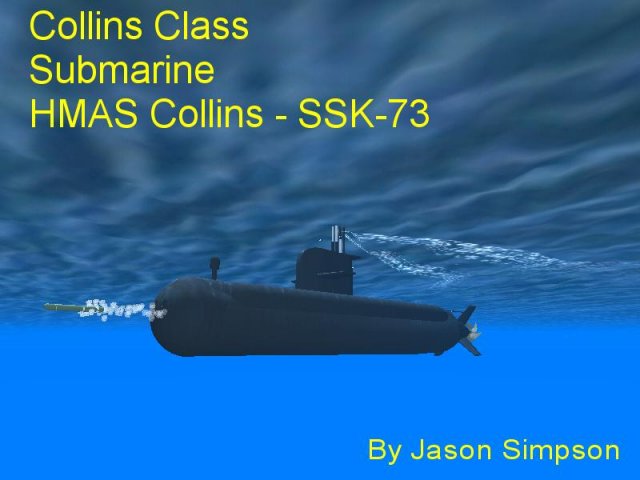
MK-48 Torpedo
Torpedoes are self-propelled guided projectiles that operate underwater and are designed to detonate on contact or in proximity to a target. They may be launched from submarines, surface ships, helicopters and fixed-wing aircraft. The three major torpedoes in the Navy inventory are the Mark 48 heavyweight torpedo, the Mark 46 lightweight and the Mark 50 advanced lightweight.
The MK-48 is designed to combat fast, deep-diving nuclear submarines and high performance surface ships. It is carried by all Navy submarines. The improved version, MK-48 ADCAP, is carried by attack submarines, the Ohio class ballistic missile submarines and will be carried by the Seawolf class attack submarines. The MK-48 replaced both the MK-37 and MK-14 torpedoes. The MK-48 has been operational in the US Navy since 1972. MK-48 ADCAP became operational in 1988 and was approved for full production in 1989. The SSN 714 Norfolk fired the first ADCAP torpedo on 23 July 1988, sinking the FORREST SHERMAN class destroyer DD 938 Jonas K. Ingram. MK-48 and MK-48 ADCAP torpedoes can operate with or without wire guidance and use active and/or passive homing. When launched they execute programmed target search, acquisition and attack procedures. Both can conduct multiple reattacks if they miss the target.
A highly capable weapon, the MK 48 can be used against surface ships or submarines, and has been test fired under the Arctic ice pack and in other arduous conditions. The ADCAP version, in comparison with earlier MK 48 torpedoes, has improved target acquisition range, reduced vulnerability to enemy countermeasures, reduced shipboard constraints such as warmup and reactivation time, and enhanced effectiveness against surface ships. The MK 48 is propelled by a piston engine with twin, contra-rotating propellers in a pump jet or shrouded configuration. The engine uses a liquid monopropellant fuel, and the torpedo has a conventional, high-explosive warhead. The MK 48 has a sophisticated guidance system permitting a variety of attack options. As the torpedo leaves the submarine's launch tube a thin wire spins out, electronically linking the submarine and torpedo. This enables an operator in the submarine, with access to the submarine's sensitive sonar systems, initially to guide the torpedo toward the target. This helps the torpedo avoid decoys and jamming devices that might be deployed by the target. The wire is severed and the torpedo's high-powered active/passive sonar guides the torpedo during the final attack.
The MK 48 Mod 5 ADCAP torpedo is an improvement to the MK 48 submarine launched torpedo. It is a heavyweight acoustic homing torpedo with sophisticated sonar and a fuzed warhead. The ADCAP enhancement includes all digital guidance and control systems, digital fuzing systems, and pro-pulsion improvements which add speed, depth, and range capability. The Navy will produce about 1046 MODS ADCAPs, replacing an equivalent number of baseline (Mod 5) ADCAPs, and maintaining the total inventory of ADCAP torpedoes at 1046. One of the major advantages of using readily available technology to develop an updated weapon using the current torpedo body and off the shelf systems resulted in significant savings and reduction in the development time for the ADCAP torpedo. In addition, by using currently installed systems in place for operating and maintaing the MK-48 torpedo very little additional cost is incurred in new facilities for maintenance and repair.
The Navy developed two hardware modifications to ADCAP, called the G&C (Guidance and Control) MOD and the TPU (Torpedo Propulsion Upgrade) MOD. The G&C MOD replaces the obsoles-cent guidance and control set with current technology, improves the acoustic receiver, and adds additional memory and improves processor throughput to handle the expanded software demands anticipated for near term upgrades. The TPU MOD improves the propulsion unit as discussed in the classified version of the FY96 Annual Report. Both modifications were combined into one torpedo, the MK 48 Mod 6 (MODS ADCAP).
Software Block Upgrade III (BU III) is intended to provide a near-term improvement for use in the baseline G&C for improved performance in some key scenarios.
Software Block Upgrade IV is intended to provide a mid-term upgrade for use in the MODS G&C for improved performance in key scenarios as discussed in the classified version of this report. It will use advanced sonar and signal processing algorithms.
One engineering change planned for the MODS ADCAP, the Common Torpedo Development Vehicle (COT-DV), is planned for fleet introduction in the FY01 time frame. COT-DV is a common processor to be used on all advanced U.S. torpedoes, that will use COTS hardware and be significantly more capable than the current MODS G&C. It will initially use BU IV software.
Another hardware upgrade, Common Broadband Advanced Sonar System (CBASS), is planned for IOC in FY04. Additional information about CBASS is contained in the classified version of this report.
The ADCAP torpedo OPEVAL was completed in August 1988, and the B-LRIP report was sent to Congress in December 1988. ADCAP was reported to be operationally effective against certain threats, but not operationally effective against other threats at that time. The system was reported operationally suitable. The Navy subsequently authorized full-rate production, but Congress constrained procurement because of the concerns identified in test reporting. Modifications were implemented by the Navy to improve performance in certain scenarios, upgrade fuzing systems, and improve reliability. These modifications were considered effective. In 1994 a second software upgrade was introduced to improve performance and reliability.
The MODS ADCAP (MK 48 Mod 6), when properly employed, is more effective than the ADCAP torpedo (MK 48 Mod 5). Unfortunately, production MOD 6 ADCAPs have shown a significant vulnerability, differing from the test units. This production problem is typical of problems seen in the initial phases of LRIP. The program office is investigating. DOT&E will continue to follow this.
Performance in some environments of both ADCAP and MODS ADCAP, against certain targets employing advanced tactics and equipment, still needs to be improved. Shortfalls are discussed in the classified version of this report. The program office is aggressively working to upgrade these modes.
The MK 48 ADCAP torpedo R&D program focuses on two specific areas through FY99: Guidance and Control (G&C) software block upgrades and wideband sonar capability. The Chief of Naval Operations continues to stress shallow water (less than 600 feet) as a critical operating area to counter third world diesel electric submarines. Torpedo testing in shallow water has demonstrated that in-service ADCAP has less than full capability in this difficult environment. However, this testing, in conjunction with laboratory simulation efforts, has shown that significant performance improvements can be made by implementing changes to weapon tactics and software algorithms. Development, implementation and testing of these changes is being accomplished under the ADCAP G&C software block upgrade program.
The focus of the MK 48 ADCAP torpedo R&D program for FY99 and out has shifted from being primarily concentrated on Software Block Upgrade efforts to a coordinated hardware/software upgrade for countering evolving threats and maintaining robust performance. Countermeasure (CM) sophistication and availability on the open market directly affects ADCAP kill proficiency and its ability to counter rapidly evolving threats. The Common Broadband Advanced Sonar System (CBASS) program will develop and field a wideband sonar capable of identifying CMs and discriminating them from the target. CBASS received an ACAT III designation on 17 April 1997, with full rate production scheduled to begin in FY04.
The introduction of phased prototyping in FY01 will provide a more rapid technology transition path for incremental torpedo improvements and upgrades (including the development and test of New Technology Concepts from the R&D community (6.2) and contractor Independent Research and Development (IR&D)). This approach will incorporate accelerated in-water testing of the new concepts allowing early Fleet input into future ADCAP upgrades and help to provide the foundation for Next Generation Torpedoes. These efforts will continue torpedo development investment at a lower cost and shorter term than traditional torpedo development programs.
Specifications
Primary Function Heavyweight torpedo for submarines Contractor Gould Power Plant Air Turbine Pump Discharge (ATPD) system;
liquid (Otto) fueled swash plate engine with pumpjet propulsor.Length 19 feet (5.79 meters) Weight 3,434 lbs (1545.3 kg) (MK-48);
3,695 lbs (1662.75 kg) (MK-48 ADCAP)Diameter 21 inches (53.34 centimeters) Range Officially "Greater than 5 miles (8 km)" Claimed 40 kt 55 kt MK-48 44,550 yd 34,430 yd MK-48 ADCAP 54,685 yd 42,530 ydWeapon acquisition range 1600 yards Min/Max ASROC launching ranges 1500 to 12000 yards Speed Officially "Greater than 28 knots (32.2 mph, 51.52 kph)"
Reportedly - 40 - 55 kt.
Actual 55 knotsDepth Officially "Greater than 1,200 ft (365.76 meters)"
Reportedly 3,000 ftSearch/attack depth settings Minimum 20 yards
Maximum 1500 yardsRun characteristics 6-8 minutes
downwardGuidance System Wire guided and passive/active acoustic homing Warhead 650 lbs (292.5 kg) high explosive Date Deployed 1972
1988 ADCAPUnit Cost $2.5 million
$3.5 million (?) ADCAP -
Australia also developing Heavyweight ADCAP Torpedo with Americans, making them far in advance of anything the Singapore Navy has.

Project SEA 1429 Phase 2 Replacement Heavyweight Torpedo will acquire a replacement anti-surface warfare (ASuW) and anti-submarine warfare (ASW) heavyweight torpedo for the COLLINS Class submarine. This acquisition is to replace the Mk 48 Mod 4 heavyweight torpedo (HWT) currently in service with the Royal Australian Navy (RAN).
A Memorandum of Understanding (MOU) between the Australian and the United States Governments has been established to jointly develop the Mk 48 Advanced Capability (ADCAP) Common Broadband Advanced Sonar System (CBASS) Heavyweight Torpedo. A Joint Project Office (JPO) has been established in Washington DC to manage the CBASS program under an Armaments Cooperative Project arrangement.
The Project Scope includes the acquisition of the weapons, associated logistic support, weapon system interface equipment and transition into service.
The submarines will be progressively upgraded to accommodate the Replacement Heavyweight Torpedo, in conjunction with the Replacement Combat System (SEA 1439 Phase 4A), as part of the submarines' docking program from 2006 through to 2013.
- The upgrade of the Torpedo Maintenance Facility (TMF) at Garden Island , Western Australia was completed in March 2005 following which it entered into a period of training and consolidation prior to Certification in July 2005.
- A Torpedo System Centre was opened at Defence Science and Technology Organisation (DSTO), Edinburgh, SA in July 2004 and a Torpedo Analysis Facility was commissioned in January 2006. This facility will be used to study the performance of the new heavyweight torpedo in a high fidelity, synthetic, controlled environment.
- Mk 48 ADCAP/CBASS Developmental and Operational Testing (DT/OT) was conducted successfully in Australian waters in late 2005 with additional firings being conducted in US waters in March 2006.
- Nautronix Ltd, a Western Australian based company, in cooperation with Project SEA 1429 has developed a portable tracking range for use in shallow water. The range is being used to support developmental and operational test torpedo firings of the new weapon system.
-
Collins class can also land Austalian Special Forces who wrecked havoc in Afganistan!

Force Structure
To celebrate the 50th anniversary of the Australian Special Air Service, the Perth mint has produced the Australian SAS 1957 – 2007 1oz Silver Proof Coin
Special Air Service Regiment (SASR) is a Special Forces regiment modeled on the original British SAS and also drawing on the traditions of the Australian World War II 'Z' Special Force commando unit, as well as the Independent Companies which were active in the South Pacific during the same period. It is based at Campbell Barracks, Swanbourne, Perth, Western Australia and is a unit of the Royal Australian Corps of Infantry, part of the Australian Defense Force. They have been widely regarded as one of the better special forces units in the world; ranking alongside the British SAS/SBS and US Navy SEALs special forces.
The Australian SAS is the crack Regiment revered as the 'eyes and ears' of the Australian Defense Force, and the regimental motto is 'Who dares wins'.
Fully supported by the SAS itself, this spectacular Perth Mint release offers collectors of Australian military commemoratives a magnificent tribute with which to celebrate the Regiment’s many vital contributions throughout the world.
The coin's reverse depicts SAS soldiers in action in a variety of operational contexts. The design, which includes colored elements and the words AUSTRALIAN SAS 1957-2007, also portrays the SAS badge incorporating the words WHO DARES WINS.
Issued as legal tender under the Australian Currency Act 1965, the coin’s obverse depicts the Ian Rank-Broadley effigy of Her Majesty Queen Elizabeth II.
The coin is struck from 1oz of 99.9% pure silver in proof quality with a Coloured Reverse Design and is housed in a stylish presentation case and superbly illustrated shipper
No more than 7,500 of these coins will be released by The Perth Mint and each will be accompanied by a numbered Certificate of Authenticity.
The Australian SAS 1957 – 2007 1oz Silver Proof Coin is going to be a much sought after coin by coin enthusiasts.
-
3.What is it?
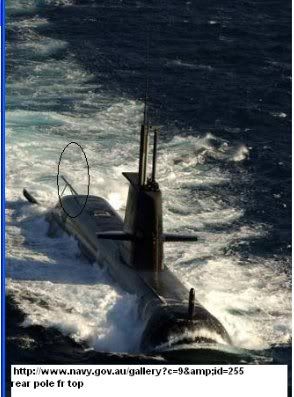
in oz sub.
i still cant find other sub in other country carrying this object?
pl tell me what is it?is it just to warn crews propellers etc submerged in the water?

What it is...
Is a sign of your ignorance




Please don't expect people to feed you your answers, the answer is so simple go and do your homework.
-
Lionnoisy
A lot of people do collect new car then pay few thousand dollars to upgrade it to look more sporty or change sound system and dvd ....that is pretty common - if not why so many car accessoires shops around singapore.
So just because Collins are ordered not to dive deep because of some pipes issues which they need to do investigation for safety reason, what wrong with that ? Even F-15 was grounded recent for checks - that does not mean anything, just safety procautions to vertify some minor part issues ... does not in anyway implies that it is not good.
You assume that singapore have 18 plaform operation a day. So everything is base on your guess and assumptions ! Wipedia - is not a authority source on information.
So what your so call 10 + 10 claims for Oz ... they have bigger ships .... what is there to compare !!!
HMAS Sydney ... ? How about british HMS Price ow Wales and HMS Repulse ? What about US Pearl habour - is not all those ships too sank by planes & sub inside their harbour. At least HMAS sydney is sunk by sub .... our was nearly sank by a container ship !!!
-
Collins Launches Harpoon ASM

The Royal Australian Navy (RAN) submarine HMAS Collins arrived at Fleet Base West in Fremantle, Western Australia, on 8 December, following a record deployment with her sister ship HMAS Waller. The two newly upgraded submarines left HMAS Stirling at the Garden Island base in Fremantle on 9 June for a marathon 183-day deployment to Hawaii and Alaska. Their voyage was the equivalent of a trip around the world, both east-west and north-south.
During the deployment the Collins became the first RAN submarine to visit Alaska, where she carried out acoustic ranging trials over the U.S. Navy's Behm Canal Southeast Alaskan Facility Range. She and the Waller were the first pair of RAN submarines to operate from Pearl Harbor in 15 years. During the Hawaiian operations Collins launched a live UGM-- 84C Sub Harpoon missile on the Barking Sands Missile Range off Kauai on 25 July, hitting the target-ship at long range.
The missile launch was part of a PCO (potential commanding officers) course involving the Collins, Waller, and the Los Angeles-class nuclear-- powered attack submarines USS Chicago and USS Santa Fe, as well as a number of U.S. and Australian maritime patrol aircraft.
-
What's lost on lionnoisy is that the Collin's size and incredible endurance will mean that it can operate in waters that no SSK in the region can, including our own. In the open ocean battle that the Australian Submarine force, with its open ocean capability plus ADCAPs and Harpoons will have an incredible advantage and reach that our RSN can only dream of, not to mention the HK capabilities of Virginia class SSNs.
-
Originally posted by storywolf:
What he will do next ? The answer is below !!!

-
Originally posted by SingaporeTyrannosaur:
Collins Launches Harpoon ASM

The Royal Australian Navy (RAN) submarine HMAS Collins arrived at Fleet Base West in Fremantle, Western Australia, on 8 December, following a record deployment with her sister ship HMAS Waller. The two newly upgraded submarines left HMAS Stirling at the Garden Island base in Fremantle on 9 June for a marathon 183-day deployment to Hawaii and Alaska. Their voyage was the equivalent of a trip around the world, both east-west and north-south.
...Tx for your lond reply.The server almost crash...
Two sub gone!!Then no sub act as a hunter deep in water lah!!
Then no sub defending oz lah.
Oh!i forget u can deploy them when u need them.
Besides,I have told u ACPB,with,1×25mm naval stabilised deck gun and
2×.50 cal Machine guns shall NOT be counted as surface combatant lah.read how RAN classify---
http://www.navy.gov.au/spc/ncamo/annex.html
PATROL BOATS
ACPB ARMIDALE (83) etc 12 ships
SURFACE COMBATANTS
FFG Upgrade
SYDNEY, MELBOURNE,etc 4 ships
FFH
ANZAC (150)
ARUNTA (151)I hope u dunt mind i still maintain my claim of
10 naval combatant platforms defending oz
in any day ,on average.,until there are fresh evidences
presented.
Patrol Boats in Oz is really patrol boats.This is for
'' to intercept and apprehend vessels
suspected of illegal fishing, quarantine, customs
or immigration offences''
http://www.defence.gov.au/budget/06-07/dar/2006-2007_defence_DAR_09_v2_s2.pdf
Oz patrol boat.Where is the weapons?


Patrol Boat in SG is in fact not--just ---patrol boats!
Weapons
76 mm OTO MELARA SRGM
MISTRAL Surface to Air Missile
WHITEHEAD Torpedoes -
Besides,I have told u ACPB,with,1×25mm naval stabilised deck gun and
2×.50 cal Machine guns shall NOT be counted as surface combatant lah.Please don't kid yourself, now you are going to tell the entire world's military how to classify surface combatants? You have no idea what you are talking about.
In fact as far as TODAY's threat profile goes, the Australian boat is actually the more SUITABLE combatant then our PVs.
For your information, by naval surface combatant standards, 76mm, Mistrals and some Whiteheads is also considered a popgun array. The 76mm cannon is no match for the automatic 2 inch mount on many destroyers and not to mention it's at the mercy of ASMs which will be what will be traded first in real life. The Mistral unfortunately, is not as effective against ASMs as the Aster.
The truth is, in a real surface battle, the SG PVs are pratically useless, they will be destroyed in a pinch by ASMs launched from REAL surface combatants, or even by something like the ADCAP striking way out of it's Whitehead range.
Not to mention worse, in today's world it's clumsy weapon loadout is less suited for the REAL threats like terrorist attacks unlike the Aussie boats with a more realistic weapon loadout and flexible mission for COIN operations with their 25mm autocannon. This is because our PV was designed as a tradeoff between being able to wage conventional warfare with some consideration for COIN and the like, but the Australians figured to go for a pratical design.
So in ACTUAL fact, the Australians did the smart thing. The best weapon for combating fast, agile pirates/terrorists will be .50cal MGs and 25mm autocannons spewing out a stream of explosive rounds, not shell by shell plinking by a 76mm gun at manuvering targets shooting RPGs back. Our PVs SAMs are useless, and the torpedos are not designed for such a threat.
In a real battle versus the "technical fast attack craft"- that is a terrorist speedboat armed with RPGs coming at you at 40 knots our PV is in serious trouble because it has no real close in weapon systems, while for the Australian craft they are well used to fighting at his range.
-
u are damn right.
oz patrol boat is just for''fast, agile pirates/terrorists''.
SG PV is for naval combats.So the weapons is not mainly for ''fast, agile pirates/terrorists'',but also can kill them.
-
WRONG, our PV will have serious issues trying to engage the new era of threats. The 76mm is too slow and clumsy to effectively engage such targets, especially if there's a large number of them moving in evasive patterns at 40 knots.
What you need is a REAL weapon, not some 76mm hammer.
What you need is a weapon that is designed to kill such new threats, not make fancy water splashes that mostly miss them.

25mm is a REAL Weapon with proven lethality, it is used in the fearsome Spooky gunship as well:

This is what it can do:

Threat facing PV from terrorism will come from small, possibly fast craft like the ones used to attack USS Cole:
Weapons our PV have like the 76mm gun, Mistral Sam and Whitehead Torpedos are not designed for such a threat but engagement of larger craft.
What we need is a rapid firing, small caliber weapon that can engage at smaller, faster targets at high speed and shred them:
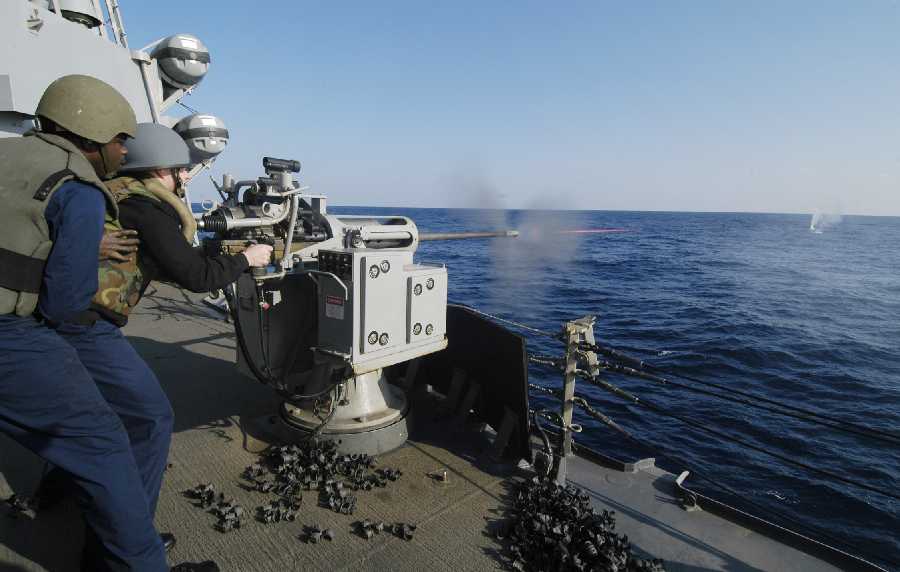
Even the Americans have learnt their lessons and installed them in their surface combatants!
United States of America
25 mm/87 (1") Mark 38 Machine Gun System -
Originally posted by lionnoisy:
u are damn right.
oz patrol boat is just for''fast, agile pirates/terrorists''.
SG PV is for naval combats.So the weapons is not mainly for ''fast, agile pirates/terrorists'',but also can kill them.
No you are WRONGAgainst fast agile pirates our PV's 76mm cannon is unable to effectively engage and they have no other weapons! All they will do is stare in horror as the 76mm shells keep missing as the terrorist speedboat bear down at 40 knots and slam into them before triggering their explosives.
This is why even the US Navy, with all their advanced weapons still mount the 25mm cannon.
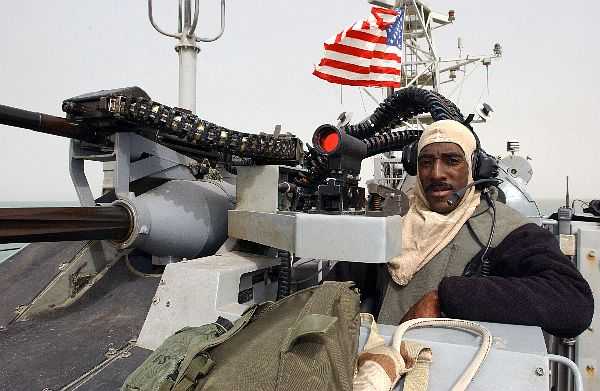
Even the Danish navy uses it:
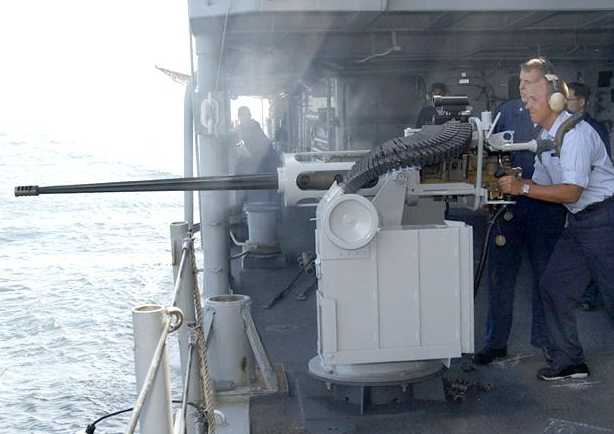
Better still, the lighter and more agile weapon can be remote controlled and engage targets at a speed way beyond our 76mm.
-
Even one 25mm round hitting a terrorist boat can do the job, shredding the terrorist and boat alike.
One 76mm round will only hit a boat if it's a lucky shot, and it's total overkill, not to mention way slower in rate of fire and gun laying.
76mm shells are also a lot more expensive and far less useful against such threats.
The 25mm cannon can spew out TWO HUNDRED of these terrorist-stopping shells per minute, way above the rate of the 76mm gun.
-

M242 Bushmaster 25mm Automatic Gun
The 25mm M242 Bushmaster cannon used on the Bradley Fighting Vehicle and a variety of land and sea vehicles. The Marine Corps carries this weapon on the Light Armored Vehicle (LAV) while the Navy carries it on many of its ocean-going vessels to deal with small attack craft. The M242 25mm "Bushmaster" Chain Gun, manufactured by McDonnell Douglas, has a single barrel with an integrated dual-feed mechanism and remote ammunition selection. Either armor piercing (AP) or high explosive (HE) ammunition may be selected with the flick of a switch. The Gunner may select from single or multiple shot modes. The standard rate of fire is 200 rounds per minute, and has a range of 2,000 meters (depending on the ammunition used). A wide range of ammunition has been developed for this weapon, making it capable of defeating the majority of armored vehicles it is likely to encounter, up to and including some main battle tanks.

